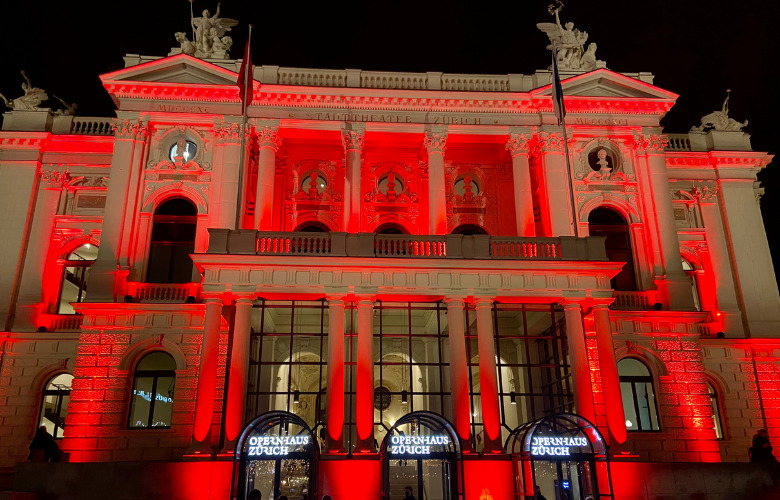
The Zurich Opera House is one of the best in the world and was named Opera House of the Year at the 2014 International Opera Awards. It is located at the Sechseläutenplatz, a big square right in front of the Opera House which is used for all kinds of cultural festivities throughout the year. The Zurich Opera House has been home of the Zurich Opera since 1891. It also houses the Bernhard-Theater Zurich as well as the Zurich Ballet.
The history of the Zurich Opera House goes back to the Aktien-Theater, which opened in 1834 with Mozart’s Magic Flute.
It was the city’s first standing theatre and was founded by theatre-loving citizens in the form of a stock company.
During Richard Wagner’s period of exile from Germany, it became his main place of work.
The corporation (today Opernhaus Zurich AG) is still the sponsor of the institution. In November 2019 they celebrated their 185th anniversary. The Canton of Zurich has been the main benefactor of the Opera House since 1995.
The old “Aktien-Theater” burned down in 1890 and was replaced by a new building designed by Fellner and Helmer.
It was built in only 16 months and became the first opera house in Europe to have electrical lighting.
The new theatre, not far from Bellevue Plaza at Lake Zurich, was almost entirely privately financed. It was inaugurated in 1891 with Wagner’s Lohengrin under the name “Stadttheater”.
The Stadttheater was the city’s main performance space for drama, opera, and musical events until 1925, when it was renamed “Opernhaus Zurich” and a theatre for plays was built: The Bernhard Theater opened in 1941.
Ever since then, opera, ballet, and theatre have been strictly separated between the two buildings. Opera and ballet are performed in the Opera House whereas everything to do with theatre plays takes place in the Bernhard Theater.
By the 1970s, the opera house was in need of major renovations. When some considered it not worth restoring, a new theatre building was proposed for the site. However, a majority voted for keeping the old Opera House. Thus, between 1982 and 1984, the renovations and rebuilding took place.
This was met with huge local opposition from the left-wing parts of the population who felt unnecessary huge amounts of money were sacrificed for this “temple of the elite”. The initial protests culminated in extensive street riots.
Still, the theatre afficionados prevailed, and the Opera House even received an extension on Uto-Quai, which also houses a studio stage as a second venue.
The rebuilt theatre was inaugurated with Wagner’s Die Meistersinger von Nurnberg and with the world première of Rudolf Kelterborn’s Chekhov opera Der Kirschgarten (The Cherry Garden).
In its restored form, the theatre is an ornate building with a neo-classical façade of white and grey stone adorned with busts of Weber, Wagner, and Mozart. Additionally, busts of Schiller, Shakespeare, and Goethe are to be found.
The auditorium is built in Neo-Rococo style and seats approximately 1’200 spectators.
During the renovations, the issue of sightlines was not adequately addressed. As a result, the theatre has a high number of seats with a limited view, or no view, of the stage.
This is unusual in international comparison, where sightlines in historic opera houses have been typically enhanced over time.
I have watched the odd performance over the years at Zurich’s Opera House, while seated behind a pillar. During one memorable Swan Lake ballet, I kept trying to catch a glimpse of what was going on onstage, only to have a sprained neck after.
This, however, is only true for the cheapest seating category. If you are prepared to pay for a better ticket, you will have an unobstructed view. And, due to the small size of the venue, the performance will feel quite magical and almost intimate… as if the artists onstage are performing exclusively for you.
In 1985 the opera orchestra was separated from the Tonhalle orchestra, and the Zurich Philharmonic Orchestra was established.
Since 1995 they also have their own baroque ensemble (La Scintilla), which was formed from among the ranks of the opera orchestra.
In addition to the eclectic annual program of opera, the Opera House also holds concerts by its Philharmonic orchestra, matinees, and events for children. The Zurich Opera Ball annually takes place in March and is usually attended by prominent European names.
Official Website, Zurich Opera House
Actor, Director, and Lecturer in Hong Kong: Billy Sy
The House of Dancing Water… Remembering a Masterpiece


Liam Klenk was born in Central Europe and has since lived on four continents. Liam has always been engaged in creative pursuits, ranging from photography and graphic design, to writing short stories and poetry, to working in theatre and shows. In 2016, Liam published his first book and memoir, 'Paralian'.
Read Full Profile© 2021 TheatreArtLife. All rights reserved.

Thank you so much for reading, but you have now reached your free article limit for this month.
Our contributors are currently writing more articles for you to enjoy.
To keep reading, all you have to do is become a subscriber and then you can read unlimited articles anytime.
Your investment will help us continue to ignite connections across the globe in live entertainment and build this community for industry professionals.